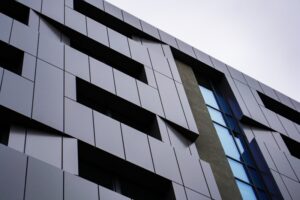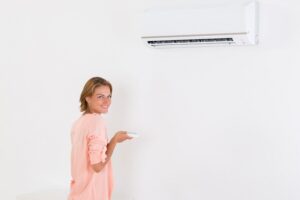Have you ever strolled past a sleek, modern building and wondered what makes its exterior look so streamlined? Are you curious about the materials that not only create an attractive facade but also provide sturdy protection against the elements? Aluminium cladding has soared in popularity, and it’s easy to see why. From boosting a building’s aesthetics to keeping maintenance costs in check, there’s a lot to unpack about this versatile material.
Whether you’re an architect, a builder, or someone planning to renovate, this article will show you how aluminium cladding might be the ideal choice for your next project. You’ll learn about durability, cost-effectiveness, and design flexibility not to mention environmental considerations and energy efficiency. If you’re keen to find the perfect cladding for your building, read on and see how aluminium could be your go-to option.
The Rise of Aluminium Cladding
Why Cladding Matters in Modern Architecture
Cladding forms the protective and decorative layer that envelopes a building’s exterior. It shields walls from rain, extreme temperatures, and general wear and tear. More importantly, it offers design freedom, helping architects craft distinct looks while maintaining the structure’s integrity. Whether it’s a commercial high-rise in Sydney or a newly renovated home in Melbourne, cladding plays a vital role in appearance and performance.
Modern architecture often prioritises minimalism, open spaces, and eco-friendly solutions. In this landscape, aluminium cladding has emerged as a standout choice. It aligns perfectly with contemporary design principles by offering clean lines, versatility in colour, and a lightweight nature. With building projects becoming increasingly elaborate, having a cladding material that can keep up without compromising aesthetic appeal is invaluable.
Overview of Aluminium as a Building Material
Aluminium is widely recognised for its strength-to-weight ratio, making it a go-to option in industries like aerospace and automotive. In construction, this translates into easier handling, faster installation, and reduced structural load. It’s also naturally resistant to corrosion, which means it stands the test of time even under challenging weather conditions.
Another benefit is its capacity for recycling. In an era where sustainability is no longer a luxury but a necessity, aluminium’s recyclability makes it an eco-friendly choice. Buildings sporting aluminium cladding can be a testament to responsible construction, proving that functionality and green considerations can indeed go hand-in-hand.
Understanding Aluminium Cladding
What Is Aluminium Cladding?
Aluminium cladding is a protective covering for a building’s exterior walls, made primarily from aluminium panels. These panels can be formed into various shapes and coated with different finishes to achieve a specific look. Some are even textured or pressed into patterned designs. The cladding is installed over the building’s structural walls, adding an extra barrier against the elements while projecting a polished facade.
Compared to traditional brick or timber, aluminium cladding brings contemporary flair without sacrificing performance. In many cases, it’s also more cost-effective in the long run thanks to its durable nature. For anyone in search of a versatile, modern, and dependable exterior solution, aluminium cladding offers a strong contender.
How Does Aluminium Cladding Compare to Other Materials?
Timber cladding gives a natural look, but it demands more frequent upkeep and can be vulnerable to rot or insect infestations if not properly treated. Brick is sturdy but heavier and sometimes more expensive to transport and install. Vinyl cladding is lightweight, but it may not stand up well under harsh Australian sun or extreme weather if the quality is subpar.
Aluminium, on the other hand, strikes a balance between durability and style. It’s lighter than steel but still highly resilient. This combination of strength and ease of handling often results in lower labour costs. Plus, many types of aluminium cladding feature specialised coatings to enhance colour retention and protect against UV rays, further extending their lifespan.

Top 6 Benefits of Using Aluminium Cladding
Durability & Weather Resistance
Aluminium cladding is known to be highly durable, resisting corrosion and weather damage even in coastal regions. It’s an especially good match for projects in Australia, where salt air, blazing sun, and sudden downpours are common. The metal’s natural oxide layer helps stave off rust, and many cladding products come with protective coatings that further reinforce this ability.
What’s more, aluminium can handle repeated exposure to rain and wind without showing signs of decay. This long-running durability reduces the need for frequent repairs or replacements, which is a relief for property owners who want to keep ongoing costs to a minimum. Knowing your building’s exterior can handle fluctuating conditions provides peace of mind throughout the year.
Lightweight & Easy Installation
A key reason builders and architects love aluminium cladding is its lightweight profile. Being lighter than alternatives like steel or concrete panels means it’s easier to transport, lift into place, and secure to the structure. In turn, installation crews can complete the job faster, decreasing overall labour expenses.
This ease of installation isn’t just about saving money, either—it also impacts design possibilities. An engineer doesn’t have to worry as much about added weight on certain building elements, so you can incorporate bold architectural designs without risking structural issues. It’s a win-win for modern projects aiming for both visual impact and construction efficiency.
Design Flexibility & Aesthetics
Aluminium cladding excels in offering a broad array of colours, textures, and patterns. Some panels mimic the look of timber, while others present a sleek, metallic finish. Whether you’re after something subtle to blend in with a heritage setting or a bold facade for a contemporary project, there’s an aluminium cladding style to match.
Designers can even shape the panels into customised forms, allowing for curved walls or striking geometric patterns. If you’re aiming for a signature architectural look, aluminium’s malleability makes that goal more achievable. This degree of flexibility is further enhanced by special coatings that retain vibrant colours over time, so your building’s appearance remains fresh.
Energy Efficiency & Thermal Insulation
Insulation is a top priority in modern builds, and the right cladding can optimise thermal performance. Aluminium cladding systems often include insulating layers behind the metal panels, helping maintain comfortable indoor temperatures. For Australian buildings dealing with both scorching summers and unexpected cold snaps, that cooling-and-heating balance can be a big plus.
Better energy efficiency translates into reduced heating or air conditioning costs. Property owners will notice the difference on their energy bills, which can be especially beneficial for commercial or multi-storey buildings. Over time, these savings add up, further demonstrating how aluminium cladding helps keep total expenses in check.
Low Maintenance & Long Lifespan
Nobody wants a building exterior that requires constant cleaning, painting, or repair work. Aluminium cladding usually just needs a periodic wash to remove dirt or debris. Its robust surface resists chipping or cracking under typical conditions, plus anti-graffiti coatings are sometimes available for buildings in high-traffic areas.
Because aluminium is naturally resistant to corrosion, you don’t have to invest as much in sealing or protective treatments compared to materials like steel. This simplicity is a big draw for property managers, especially those overseeing a portfolio of buildings. Fewer maintenance tasks mean happier owners, tenants, and operators alike.
Environmentally Friendly & Recyclable
Sustainability is increasingly front of mind for both homeowners and commercial developers. Aluminium is highly recyclable, meaning it can be reused without losing its quality. This circular life cycle helps reduce resource consumption and landfill waste, which is a major advantage in a world demanding greener construction methods.
Moreover, the production of aluminium cladding has become more energy-efficient over the years, with manufacturers opting for cleaner processes. Buildings that make use of recyclable or reusable materials, like aluminium, often attain better environmental ratings, which can boost property value.
Practical Tips for Selecting Aluminium Cladding
Quality Checks & Certifications
Make sure the panels meet relevant Australian building standards and fire safety regulations. Look for certifications from recognised bodies or ask for test results proving the product’s compliance. This is non-negotiable when you’re seeking a material that will perform effectively over the building’s lifespan.
Customising Colours & Finishes
One of the huge advantages of aluminium cladding is the wide array of colours and finishes available. From matte or gloss to metallic effects, the possibilities are extensive. Think about the overall architectural theme and how the cladding’s finish will either blend or contrast with other building elements, such as windows, doors, and roofing.
Installation Best Practices
Even a top-notch panel will fail to deliver if it’s not installed properly. Ensure the installation team follows the manufacturer’s guidelines for spacing, joint detailing, and sealing. Proper ventilation behind the panels is often critical to prevent moisture build-up. By paying attention to these details, you help guarantee the cladding’s long-term performance.
Maintenance Planning
Although maintenance needs are minimal, set up a schedule for inspection and cleaning. Dirt, grime, and salt deposits can accumulate over time, especially in coastal regions. Regular check-ups help you spot potential problems early, preventing them from escalating into larger, costlier repairs.
Conclusion
Summing up, aluminium cladding offers an appealing blend of durability, low maintenance, and design flexibility. Its recyclable nature means it’s kinder to the environment, and its weather resistance makes it especially suitable for diverse Australian climates. Cost savings over time, combined with easy installation, highlight its advantages for both commercial and residential projects. Ultimately, aluminium cladding continues to shine as a top choice in today’s architectural landscape. From cost-effectiveness to aesthetic appeal, it checks many boxes for anyone looking to maximise both form and function. If you’re contemplating a new build or a renovation, take a closer look at aluminium cladding.



